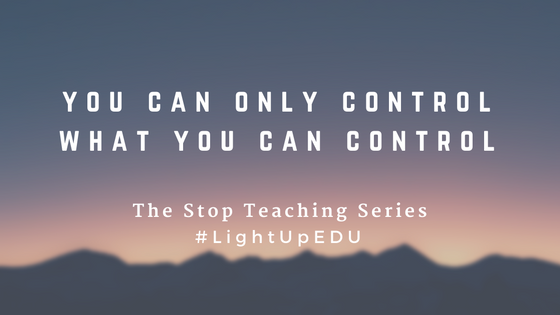Control is a funny thing. Sometimes you only feel at peace when you have it and other times you need to lose it to learn and move forward. It’s amazing, actually, that one characteristic can be so polarizing in different situations.
Control is something that educators love. Behavior, students, curriculum, assessment – the more control the better. It’s hard to say that it’s the fault of any modern educator; we just continue to fall into the trap of “it has always been that way.”
Let’s change our mindset. We need to realize that we can only truly control one thing – ourselves. For some, that may be a scary realization. Let’s break it down.
Attitude. We are in complete control of the attitude we bring into our classroom each day. Sure, things may frustrate us and vie for our attention, but all said and done we determine if we go into our classroom ready to learn and motivate or if we go in distracted, distressed, or down. Attitude is infectious and can be a major catalyst for innovation and growth in your classroom. An empty heart leads to an empty mind.
Attitude is infectious and can be a major catalyst for innovation and growth in your classroom. Click To TweetStudents. As much as we may like to believe it’s true, we can’t (and shouldn’t) control our students. Yes, some students may be “compliant” and on the surface seem controllable, but deep down we have no control over their drive, determination, or decisions. We can mentor, grow, guide, and inform in the hopes that they will make the right choices – but at the end of the day, realizing we can’t control their every move is actually quite freeing.
Curriculum. One of the most frequent comments I get from teachers when we start discussing curriculum is that they have no control and the district framework tells them what to teach. In some cases, they’re right. That said, we still have the power to discuss with our team what we cover and what we teach. By determining what your non-negotiables are (standards or units of instruction that all students will receive in a grade level) you effectively determine what can simply be covered and what you will invest time in teaching. So, while you may not directly control your framework, as a team you have tremendous control (and responsibility) in your implementation of your framework and ensuring your curriculum is guaranteed and viable.
Assessments. Chances are you have little to no control over your summative assessments. However, you are in complete control of how you get your students there. Use backwards design (reviewing and analyzing your assessment and planning backwards) to determine your goals and ensure that come assessment time your students are ready to rock. Also, be sure to collect data on what assessment questions are working and which aren’t. Remember assessments are meant to assess, not trick.
It’s easy to think that our control as educators has slipped – it has, and for all the right reasons.
Stop “controlling” and start embracing the areas you can affect change.
Stop 'controlling' and start embracing the areas you can affect change. Click To Tweet


Get new posts in your email!
Join our mailing list to receive the latest posts from LightUpEDU! We will never spam you, promise!
Please check your email to confirm your subscription!